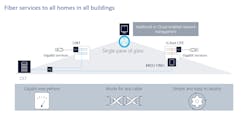Demand for broadband is relentless, in terms of the number of user service types (business, residential, 5G mobile transport), number of connected devices (with the rise of the Internet of Things) and, of course, the bandwidth consumed. Fiber is broadband network operators’ preferred choice of technology to meet this demand, and the investments and number of subscribers served by fiber access is increasing in every region of the globe, reaching almost 1 billion users in the world today.
That’s good news for us in the industry, of course, and for the millions of people now able to benefit from fiber-based broadband services. But there can be frustration for those left behind because it is not (yet) possible to draw fiber all the way to their premises. It’s also a risk for broadband operators: regulators are demanding better connectivity for everyone (no excuses), and competitors with mobile spectrum are eying fixed wireless access to steal those under-served customers away.
Multi-dwelling units (MDUs) are a particularly important area of focus. Almost half of European households live in MDUs1, and somewhere around a quarter of U.S. households2; that’s hundreds of millions of broadband subscribers. Those MDUs come in various shapes and sizes—from 4 to 40 units and 4 to 40 years old (or 400 in some European cities). There is no one-size-fits-all approach, and drawing fiber-optic cable to these homes is fraught with challenges: legal, administrative, technical, as well as objections to the aesthetic damage that is inevitably done. Nokia’s service provider customers tell us about 20% of MDUs in their service areas just cannot be fiberized.
Transparent services
Increasingly, for those MDUs that can’t be upgraded with fiber, gigabit speeds need to be extended over existing infrastructure using G.fast. The technology is an ideal solution for MDUs and shipments continue to grow in all regions of the world; analyst firm Omdia expects the G.fast installed base to double in the next four years.3 In this scenario, fiber is drawn to the basement or an outside cabinet of the building, then G.fast is used over the existing in-building wiring to connect each subscriber.
Fast and economical to deploy, in-building G.fast matches all the key metrics of gigabit fiber broadband and is, therefore, totally transparent to the user. G.fast customers simply can’t believe it’s not fiber!
- Upstream and downstream bandwidth. Full fiber-to-the-home (FTTH) customers are using Gigabit Ethernet connections from their device to their in-home optical network terminal (ONT). G.fast matches Gigabit Ethernet, so G.fast customers experience exactly the same upload and download speeds as gigabit FTTH customers.
- Latency. G.fast comes with sub-millisecond latency, perfect for video streaming, video calls, and cloud gaming.
- Stability. While copper twisted-pair in the outside plant can suffer from exposure to the elements, damage from civil works, and so on, this is not the case with in-building wiring. So, in-building G.fast service stability is not compromised.
As demand has grown, and more customers expect gigabit speeds, G.fast can still deliver. If the PON service to the building is upgraded to XGS-PON (10G symmetrical) with XGS-PON uplinks, a single MDU ONU has enough bandwidth to serve the entire building through G.fast.
Transparent management
In the past, managing multiple technologies in the same network and service area might have been a concern for operators. These days, you can easily manage G.fast services alongside PON services, even operators who only have fiber deployment experience—the last drop connection is totally transparent. G.fast works on any existing in-building point-to-point wiring for TV, data, or telephony, such as copper twisted-pair, Cat 3, Cat 5, or coax. (Figure 1).
Technology vendors now offer operators the ability, via their broadband network management system (NMS), to add G.fast subscribers without affecting FTTH services. The G.fast nodes come pre-configured, so deployment is as simple as plug and play; drop them into the network and the NMS recognizes them automatically and treats them the same as a PON optical network unit (ONU), with full visibility of the subscriber interfaces extended to the homes. With the right NMS, for all network elements and services, everything you expect for a PON deployment and operation is identical for PON and G.fast. Operators have the choice of using their traditional NMS, or a software-defined access network (SDAN) domain controller to take advantage of automation and intent-based networking.
A clear winner
Bringing a fiber service to everyone has never been easier, even in buildings that are difficult to fiberize. The performance characteristics of G.fast makes it indistinguishable from fiber for the end-user, while the ability to manage assets and services in exactly the same way makes it simple for operators to deploy G.fast within their FTTH networks.
Governments, regulators, municipalities, and operators everywhere recognize the immense social and economic advantages that ultra-broadband brings. Until such time as fiber can get to everyone, G.fast is an essential tool in the toolkit to ensure no customers are left behind.
References
1. Eurostat - Housing in Europe
2. United States Census Bureau, American Housing Survey
3. Omdia Fiber and Copper Access Equipment: Units–1Q21 (June 2021)
Zsolt Adamy is product marketing manager at Nokia Fixed Networks, responsible for fiber and G.fast product marketing. He has more than 10 years of experience in fixed access network technologies and worked formerly as pre-sales, on architecture of solutions for telecom operators and strategic industry customers. Zsolt has an MSc degree in Electrical Engineering, Branch Telecommunications.

